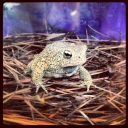Houston Toad (Anaxyrus houstonensis)
The Houston toad (Anaxyrus houstonensis, formerly Bufo houstonensis) is an endangered species of amphibian that is endemic to Texas in the United States. This toad was discovered in the late 1940s and named in 1953. Official estimates are that just 3,000–4,000 adult Houston toads are left in the world.
Description: The upper part of Houston toads is usually light brown in color, though it may sometimes be reddish. It possesses a variable number of dark brown or black spots. The underbelly is cream colored and usually very mottled. There is always at least one brown spot on the pectoral region. Females are 2 to 3.15 inches long (snout to vent). Males are smaller, being 1.7 to 2.75 inches long. Tadpoles are 0.6 to 0.9 inches long. Tadpole bodies and the upper 75% of their tails are heavily pigmented.
Habitat: Tadpoles are found in non-flowing pools that last for at least 60 days. Adults are restricted to sandy soils and prefer wooded areas interspersed with open grass. They are also found in coastal prairies. Within these habitats they are never far from water, and during the breeding season are located almost exclusively near ponds and rain pools.
Range: The Houston toad is limited to an extremely small range in southeastern Texas. Since its discovery in 1953 it has never been found north of Burleson County, south of Fort Bend County, east of Liberty County, or west of Bastrop County.
Found in these States:
TX
Diet: Tadpoles feed primarily on pollen (usually from nearby pines), the jelly envelopes of other recently hatched Houston toads, and algae on floating leaves. Adults feed primarily on ground beetles, although they have been known to eat smaller toads and ants. They utilize two methods to capture prey: sit-and-wait and active search. For the sit-and-wait method, A. houstonensis first digs a small depression in the soil with its powerful hind legs. The toad then rests in the depression and scans the surrounding area for movement. When prey is detected B. Houstonensis leaps forwards and takes the prey into its mouth. Depressions are abandoned many times per day and new ones dug nearby.
Reproduction: During February and March, the male emits a high clear trill by distending a vocal sac on its throat, in hopes of attracting a mate. A female will choose a male based on certain characteristics of his call. Small isolated pools and ponds are the toad's main breeding ground. A female toad will lay several thousand eggs in long single-egg strands that are fertilized externally by the male as they are laid. The eggs hatch within seven days and tadpoles take between 15 to 100 days to turn into little toads. The toadlets then leave the breeding pond and begin to forage for prey such as ants, beetles and moths.
Status: In 1970, the Houston toad was federally listed as an endangered species. It was extirpated from the Houston, Texas area by the 1960s, likely coincident with the severe drought of the 1950s and concurrent development of its forested habitat in that region. Though the largest and most immediate threat is habitat loss, the reduced toad populations are also vulnerable to automobiles, predators, pesticides and drought.
Subspecies: None
»» Kingdom: Animalia - Animals
»» Phylum: Chordata - Chordates
»» Subphylum: Vertebrata - Vertebrates
»» Class: Amphibia - Amphibians
»» Order: Anura - Frogs & Toads
»» Family: Bufonidae - Toads
»» Genus: Anaxyrus
»» Species: Anaxyrus houstonensis - Houston Toad
»» Subspecies: None
This article uses material from the Wikipedia article "Houston Toad", which is released under the Creative Commons Attribution-Share-Alike License 3.0. Content may have been omitted from the original, but no content has been changed or extended.
|






